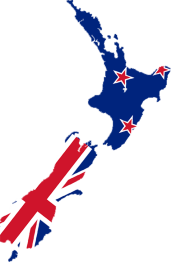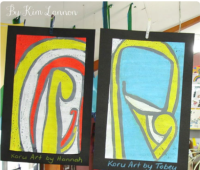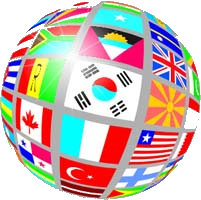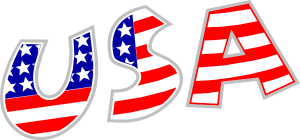New Zealand -- School-age
New Zealand
Official Name: New Zealand
The Maori name for the country is Aotearoa, "The Land of the Long White Cloud."
Capital: Wellington
County's inhabitants: Kiwi.
Abbreviation: NZ
Currency: Dollar (NZD, NZ$)
Official Languages: English and Maori with English being spoken by all.
Religion: The majority of people in New Zealand, nearly 48% of the population, are Christians.
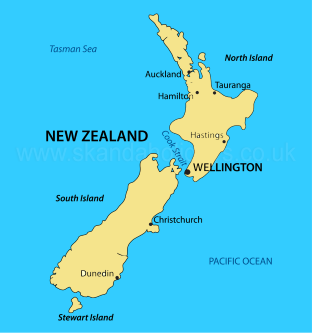
New Zealand is in the Southern Hemisphere, in the South Pacific Ocean.
Its nearest large neighbor is Australia.
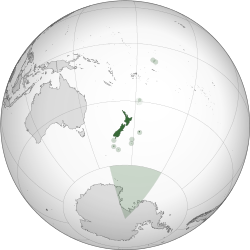
Land
New Zealand consists of two large islands; North Island and South Island, plus several smaller islands of which Stewart Island is the largest. Surrounding New Zealand to the north and east is the Pacific Ocean. Between New Zealand and Australia lies the Tasman Sea. Cook Strait separates North Island and South Island.

Mount Cook is the highest point in New Zealand.
North Island is volcanically active with a central plateau. Lake Taupo is a lake in the North Island of New Zealand. It is the largest lake in New Zealand with 616 square kilometers (238 sq mi). It is in the caldera (a large volcanic crater) of the Taupo Volcano.
South Island has the high snow covered mountain peaks and glaciers of the Southern Alps. The highest point is Mount Cook on South Island (3,754 m / 12,316 ft).
European Contact
The Maori people arrived by canoe and first settled New Zealand as early as 1000 AD. In 1642, Dutch explorer Abel Tasman was the first European to see New Zealand but never set foot on the islands.
British explorer Captain James Cook arrived on North Island in 1769. James Cook's journal of his travels inspired others to travel to the islands. At first it was whale and seal hunters. Whaling companies based in Australia would set up small stations on the main islands. The founding document of New Zealand is the Treaty of Waitangi signed in 1840 between the Maori chiefs and Great Britain. The Maori accepted British rule in exchange for protection of their land rights and giving Maori the rights of British subjects
New Zealand Government
New Zealand does not have a written constitution, no single constitutional document.
The New Zealand constitution is found in acts of parliament, decisions of the courts, documents issued by authority of the sovereign, founding documents of government, and English and United Kingdom act.
New Zealand is a parliamentary democracy under a constitutional monarchy. It is an independent country and a member of the Commonwealth which shows a long historical association with Great Britain. The British monarch is the head of state, a largely a ceremonial title. The governor-general is appointed by the British Monary and carries out the constitutional and ceremonial duties within the country, such as summoning and dissolving parliament, making state visits to other countries and receiving ambassadors, and hosting visiting heads of state.
The prime minister is the head of government. Executive power in the country resides with the prime minister and ministers.
The lawmaking body is a one-chamber parliament is elected for three-year terms.
The Judicial Branch of New Zealand handle civil and criminal cases. The interpretation of the country's law and disputes is carried out by the courts: lower and district courts, court of appeal, and supreme court.
Flag of New Zealand
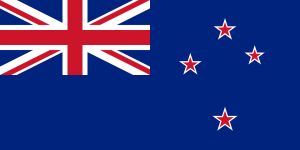
The national flag of New Zealand.
The New Zealand Flag has a deep blue background. In the top left corner, filling half the left side, is the Union Jack, the national flag of the United Kingdom. At the fly end are four stars, forming the Southern Cross constellation. Each star is red with a white border, and has five points.
Climate
New Zealand is in the Southern Hemisphere, which means January and February are the warmest months and July normally its coldest.
North Island has a warm mild climate, almost sub-tropical in the extreme north. South island is colder, Dunedin has average summer temperatures of about 15C / 59F and winter 6C / 43F.
Sir Edmund Hillary Video
Explorers
“We didn't know if it was humanly possible to reach the top of Mount Everest. And even using oxygen as we were, if we did get to the top, we weren't at all sure whether we wouldn't drop dead or something of that nature.” -Sir Edmund Hillary
Sir Edmund Hillary is New Zealand's most accomplished explorer.

Hillary and the Nepalese mountaineer Tenzing Norgay, were the first people to reach the top of Mount Everest on May 29, 1953. Hillary in 1958 becoming the first man to drive overland to the South Pole.
1953 | Edmund Hillary And Tenzing Norgay Video
Recommended Book
Everest: The Remarkable Story of Edmund Hillary and Tenzing Norgay
by Alexandra Stewart
In the late morning of May 29, 1953, the sun was shining brightly and a gentle breeze was blowing on the highest elevation of the world--and two men were there to witness it for the first time ever. Their names were Edmund Hillary and Tenzing Norgay, and they had ascended Everest. This is the breathtaking story of how two very different, yet equally determined, men battled frost-biting temperatures, tumbling ice rocks, powerful winds, and death-defying ridges to reach the top of the world's highest mountain.
Animals
New Zealand is home to many unique animal species. New Zealand is known for their flightless birds such as the Kiwi.
New Zealand is the albatross capital of the world. These sub-Antarctic islands are home to more species of breeding albatrosses than any other country.
Penguins live on the islands of the antarctic and sub-antarctic. The islands of New Zealand are sub-antarctic islands.
The yellow-eyed penguin is only found in New Zealand.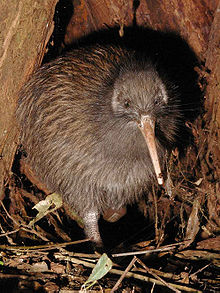
Kiwi Bird
New Zealand's offshore waters hold about 400 different marine fish: tuna, marlin, snapper, trevally, kahawai and shark. New Zealand has various species of seal, dolphins and porpoises and thirty-two species of whale have been recorded and two of the largest (sperm and humpback ) regularly migrate here in spring and autumn.
New Zealand was an island free of large predatory land mammals before humans arrived. Before human arrived, New Zealand's only mammals were bats (which flew there), and seals, sea lions, and off-shore whales (which swam there).
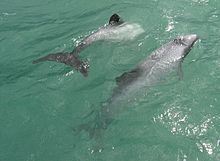
Dolphins in Porpoise Day
The arrival of the Pacific rat, Norway rat, ship rats and house mice had a harmful impact on the animals of New Zealand. Rodents are believed to be responsiable for the extinction of many bird species.
https://www.wired.com/story/the-quest-to-purge-new-zealand-of-invasive-predators/
New Zealand Is Famous For
New Zealand is famous for its connection to the Lord of the Rings movie. The amazing natural landscapes in New Zealand is why it was chosen as the Lord of the Rings filming location.
The Kiwi (bird). The word kiwi can be used to refer to the bird or the people of New Zealand. When "the" is in front it means the bird. Usually when "a" is in front it means a New Zealander.
The kiwifruit or Chinese gooseberry, is grown commercially in New Zealand but it is not native to New Zealand. The kiwifruit is native to northern China and Taiwan. The kiwifruit or Chinese gooseberry was renamed "Kiwi Friut" for marketing purposes.
Maori Culture and the Haka (A Maori ceremonial war dance involving chanting.)
Rugby is the most popular sport in New Zealand. The All Blacks are the national team. A Haka imitation is performed by New Zealand rugby teams before a match.
Haka | All Blacks Rugby Team Video
New Zealand Products
New Zealand has a free-market economy. Its economic sectors are service industries (banking, insurance, and tourism), agriculture, fishing, forestry, manufacturing and mining.
There is large scale manufacturing industries that includes: aluminium production, food processing, metal fabrication, wood and paper products.
Agriculture is New Zealands leading exports with the main export products: dairy, meats, fruits, wood products such as paper, and crude oil.
Things to Do
Kiwi color page at crayola.
New Zealand Flag & Map color page at crayola.
Sites to See
Giant Squid Visit the Smithsonian Institute website where you can learn everything there is to know about squids of all kinds, the scientists who study squids, and their expedition to New Zealand to try to see one of these enormous sea creatures.

